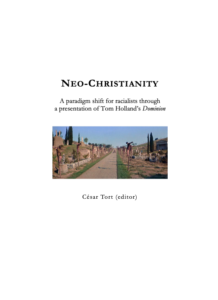Editor’s note: Ten years ago, I quoted a few paragraphs from William Pierce’s article ‘Christianity’. Today I reread it in its entirety in a National Alliance article. Although I am more radical than Pierce when it comes to the religion of our parents, I reproduce it below because it stands in stark contrast to the secular sympathisers of Christianity on today’s racialist forums.
Pierce wrote:

THE NATIONAL ALLIANCE IS not a religious organization, in the ordinary sense of the term. It does, however, have to concern itself with religious matters, because religions influence the behavior of people, society, and governments. The doctrines of various religious groups—Christians, Muslims, Jews, Buddhists, et al.—deal with temporal as well as spiritual matters and therefore often conflict with National Alliance doctrine.
Christian doctrines are of much greater concern to the National Alliance than the doctrines of other large religious groups, because Christianity is the most influential religion in the United States, Europe, and the rest of the White world. Most members of the National Alliance come from families which are, or a generation ago were, at least nominally Christian, and very few come from families which practice, or practiced, Islam, Buddhism, or other religions. Furthermore, the history of our race for the last thousand years has been inextricably bound up with Christianity. The National Alliance really cannot avoid taking positions regarding Christian beliefs and practices, despite the complications this causes in our work.
The immediate and inevitable fact which forces us to come to grips with Christianity is that the mainstream Christian churches are all, without exception, preaching a doctrine of White racial extinction. They preach racial egalitarianism and racial mixing. They preach non-resistance to the takeover of our society by non-Whites. It was the Christian churches, more than any other institution, which paralyzed the will of White South Africans to survive. It is the Christian establishment in the United States which is preeminent in sapping the will of White Americans to resist being submerged in the non-White tide sweeping across the land. Most Christian authorities collaborate openly with the Jews, despite the contempt and abuse they receive in return, and the rest at least follow Jewish policies on the all-important matter of race. The occasional anomaly—a Catholic bishop in Poland speaking out angrily against Jewish arrogance, a few Protestant groups in the United States expressing sympathy for oppressed Palestinians—does not invalidate the rule.
We are obliged, therefore, to oppose the Christian churches and to speak out against their doctrines. But we do not, as some groups have done, accuse the Christian leaders of being false Christians. We do not say, “We are the real Christians, because we stand for the values which the mainstream churches stood for a century ago, before they were subverted.” We do not reach for our Bibles and point to verses which seem to be in accord with the policies of the National Alliance and contrary to the present policies of the Christian churches. A diligent Bible scholar can find in the Judeo-Christian scriptures support for—or ammunition against—virtually any policy whatsoever.
Beyond the immediate conflict between us and the Christian churches on racial matters, there is a long-standing and quite fundamental ideological problem with Christianity. It is not an Aryan religion; like Judaism and Islam it is Semitic in origin, and all its centuries of partial adaptation to Aryan ways have not changed its basic flavor. It was carried by a Jew, Saul of Tarsus (later known as Paul), from the Levant to the Greco-Roman world. Its doctrines that the meek shall inherit the earth and that the last shall be first found fertile soil among the populous slave class in Rome. Centuries later, as Rome was succumbing to an internal rot in which Christianity played no small part, legions of Roman conscripts imposed the imported religion on the Celtic and Germanic tribes to the north.
Eventually Christianity became a unifying factor for Europe, and in the name of Jesus Europeans resisted the onslaught of Islamic Moors and Turks and expelled the “Christ-killing” Jews from one country after another. But the religion retained its alien mind-set, no matter how much some aspects of it were Europeanized. Its otherworldliness is fundamentally out of tune with the Aryan quest for knowledge and for progress; its universalism conflicts directly with Aryan striving for beauty and strength; its delineation of the roles of man and god offend the Aryan sense of honor and self-sufficiency.
Finally Christianity, like the other Semitic religions, is irredeemably primitive. Its deity is thoroughly anthropomorphic, and its “miracles”—raising the dead, walking on water, curing the lame and the blind with a word and a touch—are the crassest superstition.
We may have fond memories of the time before the Second World War when pretty, little girls in white dresses attended all-White Sunday schools, and Christianity seemed a bulwark of family values and a foe to degeneracy and indiscipline. We may cherish the tales of medieval valor, when Christian knights fought for god and king—if we can overlook the Christian church’s bloodthirsty intolerance, which stifled science and philosophy for centuries and sent tens of thousands of Europeans to the stake for heresy or witchcraft.
We may even find Christian ethics congenial, if we follow the standard Christian practice of interpreting many of its precepts—such as the one about turning the other cheek—in such a way that they do not interfere with our task. But we should remember that nothing essential in Christian ethics is specifically Christian. Any successful society must have rules of social conduct. Lying and stealing were shunned in every Aryan society long before Christianity appeared. Our pagan ancestors did not need Christian missionaries to tell them how to behave or to explain honor and decency to them—quite to the contrary!
Historians may argue the pros and cons of Christianity’s role in our race’s past: whether or not the unity it provided during a period of European consolidation outweighed the loss of good genes it caused in the Crusades and the bloody religious wars of the Middle Ages (and through the Church’s policy of priestly celibacy); whether the splendid Gothic cathedrals which rose in Europe during four centuries and the magnificent religious music of the 18th century were essentially Christian or essentially Aryan in inspiration; whether Christianity’s stand against the evils of self-indulgence—against gluttony and drunkenness and greed—was worth its shackling of the human mind in superstition or not. One thing already is clear, however: Christianity is not a religion that we can wish on future generations of our race.
We need ethics; we need values and standards; we need a world view. And if one wants to call all of these things together a religion, then we need a religion. One might choose instead, however, to call them a philosophy of life. Whatever we call it, it must come from our own race soul: it must be an expression of the innate Aryan nature. And it must be conducive to our mission of racial progress. Christianity, as the word is commonly understood, meets neither of these criteria.
The fact is that, completely aside from the racial question, no person who wholeheartedly believes Christian doctrine can share our values and goals, because Christian doctrine holds that this world is of little importance, being only a proving ground for the spiritual world which one enters after death. Christian doctrine also holds that the condition of this world is not man’s responsibility, because an omnipotent and omniscient deity alone has that responsibility.
Although some Christians do believe Christian doctrine wholeheartedly, however, most do not. Most instinctively feel what we explicitly believe, even if they have repressed those feelings in an effort to be “good” Christians. Because of this many nominal Christians, even those affiliated with mainstream churches, can, under the right circumstances, be persuaded to work for the interests of their race. Other nominal Christians—especially those who stand apart from any of the mainstream churches—have interpreted Christian doctrine in such an idiosyncratic way that the contradictions between their beliefs and ours have been minimized.
For these reasons we want to avoid conflict with Christians to the extent that we can. We don’t want to give unnecessary offense, even when we speak out against the doctrines of their churches. We don’t want to ridicule their beliefs, which in some cases are sincerely held. Some of these people later will reject Christianity’s racial doctrines. Some will reject Christianity altogether. We want to help them in their quest for truth when we can, and we want to keep the door open to them.
Members who want to study the subject of Christianity and its relationship to our task in depth should read Which Way Western Man?, by our late member William Simpson. The book’s initial chapters describe the spiritual odyssey of a man of exceptional spiritual sensitivity, who was far more intensely a Christian than nearly any Christian living today and who eventually understood the racially destructive nature of Christianity and rejected it.
______ 卐 ______
[Kevin Alfred Strom comments:] One of the most important statements William Pierce made on the subject was 1982’s “On Christianity,” published in the National Alliance BULLETIN and now available on nationalvanguard.org, in which he says
______ 卐 ______
No honest, conscientious Alliance member can maintain his membership in the Alliance and also in an organization which is fundamentally opposed to the goals and principles of the Alliance. [A] former member who belongs to the Moral Majority acted correctly in resigning from the Alliance, and the same applies to others: Any Alliance member who is also a member of a church or other Christian organization which supports racial mixing or Zionism should decide now where he stands, and he should then resign either from his church or from the Alliance.
In fact, the great majority of Alliance members who originally had some Christian church affiliation have already made their decisions and left the churches….
If, despite everything above, there are Alliance members or prospective Alliance members who still consider themselves Christians, then it must be in the sense that they value the specifically White elements of Christianity which have been added since its origins—the great art, the great music, and the great architecture produced by White men during the centuries in which the Christian churches ruled Europe—and that they also share the White spiritual feelings which have been eloquently expressed by many men and women who were Christians and who applied the adjective “Christian” to feelings which, in fact, came from deep within the White race-soul and existed long before the advent of the Christian church. Such Christians we can call our comrades and be proud to have in our ranks.







